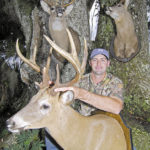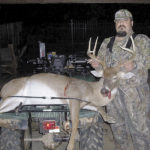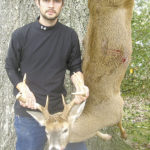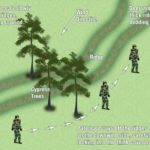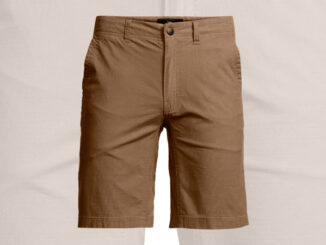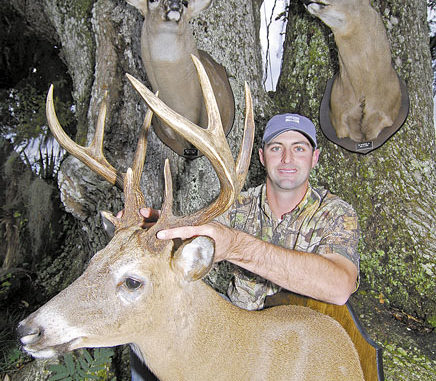
Once the rut ends, bucks seem to disappear. But they are still around, and there are some basic needs that make them vulnerable.
The hunters had put in so much time afield that interest had ebbed, so when the morning broke on Jan. 20, no one showed much desire to leave the camp. They slept late, and then lounged around, enjoying the last of the season’s camaraderie. “Everybody was hunted out, and I stayed in like everybody else,” Ira Patureau Jr. said. “We were just hanging out watching hunting shows.”
Several weeks of hard hunting in the swamps of Assumption Parish had taken their toll, and the hunters had pretty much conceded defeat and refused to take advantage of the last day of rifle season.
Like the hunters, the big buck was just worn out. It had been a long couple of weeks, with the animal running wild. There were exhausting fights, a few ending in defeat but most being rewarded with the lusty fruits of victory.
Throughout that time, little attention had been given to anything but the pursuit of love. The once-full body of the deer was emaciated, with body weight sacrificed to the drive of Mother Nature.
The main thrust of the breeding season had passed, however, and the buck barely had energy to hold up its head. The deer had spent the night resting, catching up on lost sleep and trying to clear its head from the rut-crazed fog.
After several hours of sleep, it realized the emptiness of its stomach was growing. It ignored it as the sun rose, and closed its eyes for a couple more hours of rest.
In Patureau’s camp, the hunting shows began stoking an ember of interest deep within the young hunter, and it wasn’t long before he was getting ready for one final hunt.
“About 10 a.m., I decided to go back where I had killed a spike,” he said.
He hurried to get ready, his buddies rolling their eyes and giving Patureau some good-natured ribbing.
Making a final check of the wind, he gathered his gear and jumped into his father’s truck for the short ride to his mud boat that would take him deep into the swamps.
Patureau knew some ridges used as bedding areas, and he hoped he’d be able to catch an old mossy-back resting up.
The buck wasn’t alone on the ridge. There was another buck, not quite as big but still not a youngster, laid up just downwind. Only days ago, neither of the animals would have tolerated such close company, and one of the deer would have had to move on or a vicious fight would have ensued.
Now, they weren’t interested in sparring. Their testosterone levels had begun to abate, and they were content with company — much as brothers eventually come together again after a physical disagreement.
The bigger buck opened its eyes, and again felt the need to rebuild its physical strength. It shook its head, and finally stood up.
Its companion poked its head over the thick cover at the sound, and pulled itself to its feet. The bucks spent a few minutes socializing, but it wasn’t long before their growling stomachs focused their thoughts.
Patureau had driven the mudboat into the swamp, and then traded for a pirogue in which he could continue deeper into the swamp without making so much noise.
After finally reaching a series of ridges, the young man stepped into the water and eased parallel to the high spot. He didn’t move swiftly, taking only a few steps at a time before stopping and carefully scanning the cover along the ridge.
“I was in knee-deep water, and I was downwind of the ridge so the deer couldn’t smell me,” Patureau said.
He didn’t see anything, and moved on to the next ridge. This new target was actually where Patureau had killed the spike, and he believed it would be his best chance at catching a bedded deer.
Moving slowly, Patureau eased to the end of the boomerang-shaped ridge. He remained in the water, however.
“It’s a cypress flat on an old sunken ridge,” he explained. “I passed the stand where I shot that spike, and I just started scanning the ridge.”
The bucks eased through the cover with barely a sound, working their way upwind. They nipped at vegetation here and there, but finally reached the apex of the curved ridge. Without a look, the younger buck broke away and continued along the top of the ridge.
The more-mature deer continued straight, slipping into the water and working its way through a stand of cypress surrounded by flooded dollar weeds.
Lowering its head, the animal bit off some of the vegetation. Soon it was absorbed with eating, savoring the succulent leaves as it gorged itself and looked toward regaining the strength and energy it had lost during the exhausting rut.
Patureau continued stalking into the wind, working very, very slowly and memorizing every inch of the ridge so he could recognize any anomaly.
“You could really see a lot,” he said. “I was sneaking at a snail’s pace, taking two to three steps and stopping.”
After about 60 yards, Patureau reached the tip of the ridge where it curved away from him. Making one more careful search of the brush-strewn high ground, he took a couple of steps and froze.
“I rounded that point, and when I cleared the cypress, I saw a deer standing in the water,” he said.
The hunter slowly pulled back behind the cover of a cypress tree, collected himself and eased his head out again for another quick look.
“I glanced at it, and I could see it had horns, but I couldn’t tell how big it was,” Patureau said. “I didn’t get too worked up about it.”
He took a couple of more breaths, and eased around the cypress tree in preparation for a shot. The buck was still just standing there eating, intent on its meal and oblivious to its surroundings.
“I eased out and put the crosshairs behind the shoulder and squeezed the trigger,” Patureau said.
The buck had made few mistakes in its life, learning young that it paid to be careful. However, the hunger that was eating at its belly consumed the animal. It just couldn’t get enough of the vegetation.
So it never knew the hunter was there until a loud pop accompanied a sharp pain in its side.
Instinct took over, and hunger was replaced by an adrenaline-laced need to escape. The big animal took a bounding leap, splashing through the water as it tried to escape.
But it wasn’t long before the deer couldn’t continue, and its legs folded under it. The deer slammed down, and its head sank beneath the water.
When the little .25-06 bucked, Patureau saw the deer jump and disappear behind the flooded cypress. Of course, the benefit of hunting the swamps is it was easy to hear deer when they ran. So the hunter could track the deer by sound, and finally heard the satisfying crash as the deer went down.
“When I got to the deer, half of the rack was sticking above the water,” Patureau said.
He hurried to the deer and pulled its head up using the visible antler, which was already impressive.
“I started pulling this thing out the water, and I had no idea that’s what I shot,” he said.
The main-frame 8-pointer was impressive, with an additional couple of points to round out the massive set of antlers.
“The rack was huge, but the deer was rutted out,” Patureau said. “It only weighed 175 pounds; it was skinny as hell.”
The deer eventually taped out at 140 7/8.
